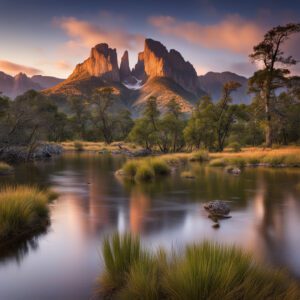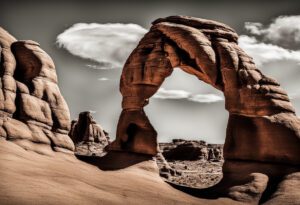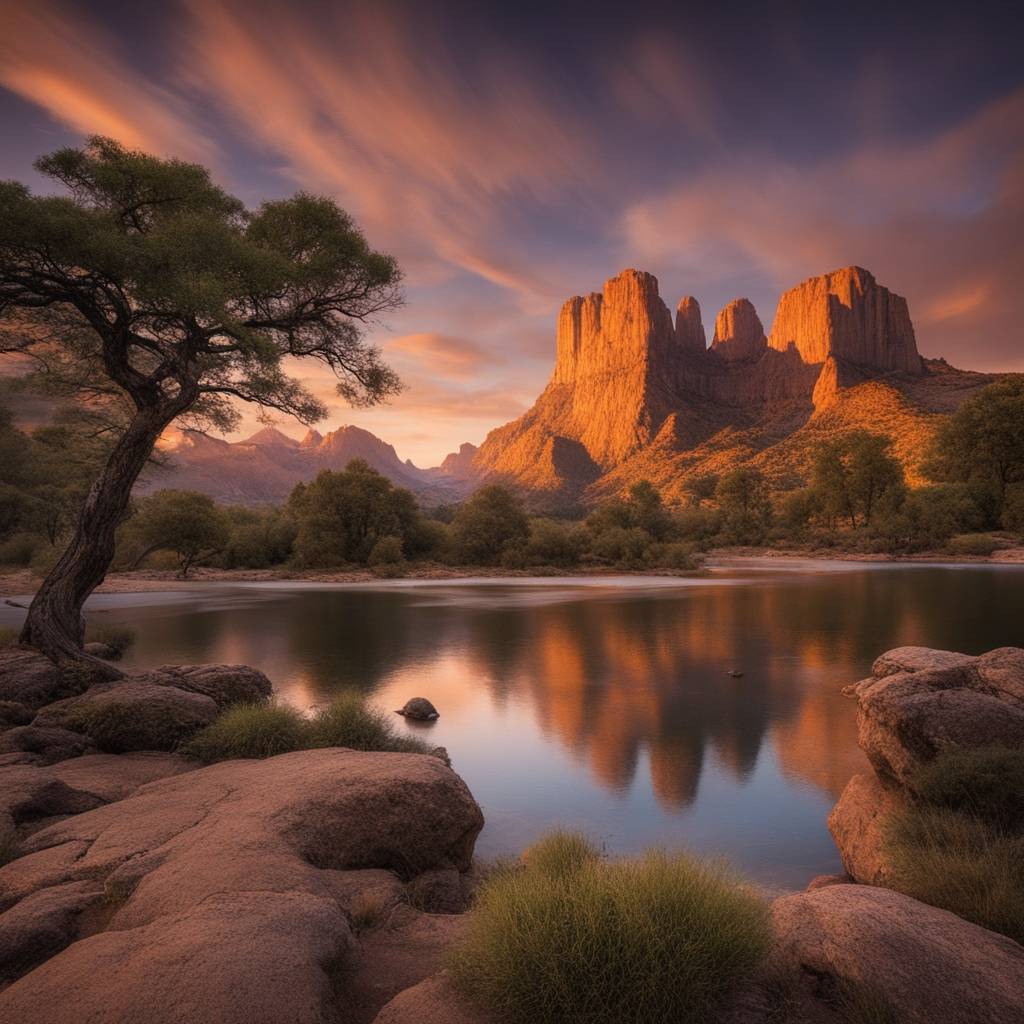7 Wonders of Arches National Park: Exploring Nature’s Sculpture Garden
Introduction
Welcome to the red rock wonderland, where nature’s artistic prowess takes center stage – Arches National Park! Nestled in the heart of Utah, this desert gem is a playground of surreal landscapes that will leave you awe-inspired. Picture colossal arches carved by time, vibrant sunsets painting the sandstone hues, and a sense of tranquility that can only be found in the embrace of the great outdoors.
In this blog, we’re about to embark on an adventure through the iconic Arches National Park, where each arch tells a story and every rock formation is a masterpiece. From the famous Delicate Arch to hidden gems tucked away in the fiery canyons, join us as we unravel the secrets of this natural sculpture garden. Get ready for a journey filled with breathtaking views, fascinating tales, and the kind of serenity that only the Utah desert can offer. So, lace up your hiking boots, grab your camera, and let’s dive into the captivating beauty of Arches National Park!

General Information:
What is Arches National Park? Arches National Park is a stunning national park located in Utah, renowned for its natural sandstone arches and unique rock formations. It is a testament to the geological wonders shaped by erosion and time.
Where is Arches National Park located? Arches National Park is situated in southeastern Utah, near the town of Moab. The park covers over 76,000 acres of red rock landscapes.
How to get to Arches National Park from Salt Lake City? The most common route is via I-70 E and US-191 S. The approximate driving distance is around 230 miles, taking you through scenic landscapes.
What is the closest airport to Arches National Park? The closest major airport is Grand Junction Regional Airport (GJT) in Colorado, approximately 110 miles away.
Weather and Seasons:
What is the weather like at Arches National Park? Arches National Park experiences a semi-arid climate. Summers are hot, with temperatures often exceeding 100°F, while winters are cooler, ranging from mild to cold.
When is the best time to visit Arches National Park? The spring and fall months, particularly April to May and September to October, offer milder temperatures and are considered the best times to visit.
What is the elevation of Arches National Park? The elevation of Arches National Park ranges from around 4,085 feet at the visitor center to over 5,600 feet at Elephant Butte.
Activities and Attractions:
What are some must-do activities in Arches National Park? Hiking to iconic arches like Delicate Arch, exploring Devil’s Garden, and witnessing the sunrise at key viewpoints are must-do activities.
Are there guided hikes available in Arches National Park? Yes, the park offers ranger-led programs and guided hikes, providing insightful information about the park’s geology and ecology.
What are some popular hikes in Arches National Park? Delicate Arch Trail, Devil’s Garden Loop, and Landscape Arch Trail are among the popular hikes, each showcasing the park’s natural beauty.

Camping and Accommodation:
Is camping allowed in Arches National Park? Yes, there are camping facilities available at the Devils Garden Campground. Reservations are recommended, especially during peak seasons.
Are there hotels near Arches National Park? While there are no hotels within the park, the town of Moab, located nearby, offers various lodging options to suit different preferences and budgets.
Can you provide information on RV camping near Arches National Park? There are RV parks near Arches National Park, offering facilities for those traveling with recreational vehicles.
Travel and Transportation:
What are the driving distances from Las Vegas and Denver to Arches ? The distance from Las Vegas is approximately 360 miles, and from Denver, it’s around 350 miles.
Are there shuttle services from Moab to Arches ? While there are no direct shuttle services, there are tour companies in Moab that offer guided trips to Arches National Park.
Is there an airport for Arches ? The park itself doesn’t have an airport. Grand Junction Regional Airport (GJT) is the nearest major airport.
Specific Landmarks and Areas:
What is Delicate Arch in Arches National Park? Delicate Arch is an iconic, freestanding natural arch and one of the most recognized symbols of Utah. It requires a moderate hike to reach.
Are there other notable arches in Arches ? Yes, Arches National Park is home to over 2,000 natural stone arches, including Double Arch and Landscape Arch.
Can you provide information on Devil’s Garden in Arches? Devil’s Garden is a section of the park known for its trailhead leading to several arches, including the famous Landscape Arch.
Safety and Regulations:
Are dogs allowed in Arches National Park? While pets are allowed in certain areas of the park, they must be leashed. However, they are not allowed on most trails.
What safety regulations should visitors be aware of in Arches National Park? Visitors should adhere to safety guidelines, stay on designated trails, carry

Guide:
Weather:
Embarking on a journey through Arches National Park promises a dynamic experience, with the weather casting its own spell on the mesmerizing landscapes. Summers paint the park in hues of warmth, encouraging exploration during the day, while spring and fall offer a more temperate backdrop for outdoor adventures. Before setting out on your expedition, it’s wise to check the weather forecast to ensure you’re equipped for the elements and can make the most of your visit, capturing the ever-changing beauty of this natural wonder.
Map:
Navigating the enchanting labyrinth of Arches National Park becomes a delightful quest with the guidance of its detailed map. Every contour and arch is artfully depicted, unveiling a tapestry of geological marvels waiting to be explored. Whether you’re chasing the silhouette of Delicate Arch or venturing into the remote corners of Devil’s Garden, this map is your trusted companion, turning each visit into a personalized adventure through the red-rock wonders of Arches.
Arches National Park Photos:
In the heart of Arches National Park lies a photographer’s paradise, where every turn reveals a canvas of natural artistry. From the delicate grace of Delicate Arch to the whimsical curves of Landscape Arch, each snapshot encapsulates the park’s unparalleled beauty. These photos not only freeze moments in time but also serve as windows into the captivating allure of Arches. Every image tells a story, inviting others to embark on their own visual journey through the arches, spires, and mesas that define this extraordinary landscape.
Arches National Park Reservations:
Ensuring a seamless journey into the heart of Arches National Park, reservations play a key role in securing sought-after experiences. Whether it’s reserving a campsite beneath a star-studded desert sky or guaranteeing access during peak seasons, these reservations unlock the full potential of your adventure. As the sun sets behind iconic arches, having your plans in place ensures that you can focus on absorbing the magic of the moment rather than logistical details.
Arches National Park Hikes:
For those seeking communion with the raw beauty of nature, Arches National Park unfolds a tapestry of hiking trails. Each step reveals a new perspective, whether you’re ambling through the iconic Delicate Arch Trail or navigating the challenging terrain of Devil’s Garden. These hikes aren’t just paths; they are invitations to immerse yourself in the untouched wilderness, forging a connection with the ancient forces that shaped these captivating rock formations.

Arches National Park Tickets:
To unlock the gateway to Arches National Park’s extraordinary landscapes, a ticket becomes the key to a realm shaped by wind, time, and geological wonders. Each ticket opens the door to a canvas of red rocks, soaring arches, and the silence of the desert. It’s not merely an entrance fee; it’s a passport to an encounter with nature’s masterpieces, where every arch is a testament to the enduring dance between earth and sky.
Adventurous Hiking Trails in Arches National Park:
Embarking on a journey through Arches National Park is like stepping into a natural wonderland, where every trail promises breathtaking views and unique geological formations. For those seeking an extra dose of adventure, the park offers a selection of hiking trails that go beyond the well-trodden paths. Lace up your boots and get ready for an adrenaline-pumping exploration of Arches’ more adventurous side.
Fiery Furnace: Navigating the Labyrinth
Venture into the heart of Arches National Park with the Fiery Furnace, a maze of narrow passages and towering sandstone walls. This challenging trail is more than just a hike; it’s a navigation exercise. While the park offers guided ranger tours, experienced hikers can obtain a permit and explore this labyrinthine wonder independently. Expect to squeeze through tight spaces, scramble over rocks, and be rewarded with views of arches hidden from the main trails.
Devil’s Garden Primitive Loop: Beyond the Beaten Path
For those craving a longer and more rugged adventure, the Devil’s Garden Primitive Loop is the answer. This trail extends beyond the popular Devil’s Garden Trail, offering a challenging loop that introduces hikers to lesser-known arches like the stunning Double O Arch. Be prepared for narrow ledges, rock scrambling, and an up-close encounter with the park’s diverse geological features.
Tower Arch Trail: A Remote Wilderness Experience
Escape the crowds and delve into the remote wilderness of Arches with the Tower Arch Trail. This less-traveled path takes hikers on a journey through open desert terrain, showcasing the expansive beauty of the park. Tower Arch itself, a massive and isolated structure, stands as a testament to the forces shaping this unique landscape. The trail’s solitude provides a serene and immersive experience for those seeking a deeper connection with nature.
Klondike Bluffs Trail: Red Rock Wonderland
For a taste of the surreal red rock landscapes of Arches National Park, the Klondike Bluffs Trail delivers. Offering panoramic views of the surrounding area, this moderately strenuous trail winds through towering fins and spires. The highlight is the Mars-like terrain of the Klondike Bluffs, where hikers can marvel at the contrast of deep red rocks against the clear desert sky.
Important Tips for Adventurous Hiking:
1. Permits:
- Obtain necessary permits for trails like the Fiery Furnace or any designated backcountry areas. Permits are essential for both safety and conservation efforts.
2. Safety First:
- Wear sturdy hiking boots, carry ample water, and be equipped with a map and compass. Some trails may involve scrambling or navigating through challenging terrain.
3. Check Trail Conditions:
- Verify trail conditions and closures before embarking on your adventure. Flash floods, weather changes, or maintenance work can affect trail accessibility.
4. Leave No Trace:
- Respect the delicate desert ecosystem by following Leave No Trace principles. Stay on designated trails, pack out all waste, and minimize your impact on the environment.

8 Fascinating Facts That Make Arches National Park a Natural Marvel:
- Nature’s Sandstone Symphony: Arches National Park, located in southeastern Utah, orchestrates a captivating symphony of sandstone formations, boasting over 2,000 natural stone arches. Carved by the patient hands of erosion and time, these delicate arches create a breathtaking spectacle that draws nature enthusiasts and adventurers from around the globe.
- Giant’s Playground: The park’s landscape is akin to a giant’s playground, where colossal red-rock monoliths stand as silent sentinels. The most iconic among them is the Delicate Arch, a gravity-defying structure that graces Utah license plates and represents the quintessence of the American Southwest.
- Millennia in the Making: Arches National Park is a testament to the slow and meticulous artistry of geological forces. The arches and rock formations tell a story that spans millions of years, as layers of sedimentary rock were deposited, uplifted, and sculpted by wind and water into the mesmerizing shapes we witness today.
- Night Skies Unveiled: As the sun sets over the Utah desert, Arches National Park transforms into a celestial theater. Designated as an International Dark Sky Park, it offers unparalleled opportunities for stargazing. The expansive, unpolluted skies reveal a dazzling tapestry of stars, planets, and celestial wonders, creating an awe-inspiring celestial experience.
- Ancient Puebloan Connections: Before becoming a national park, the area now known as Arches was home to ancient Puebloan peoples. Evidence of their presence, including petroglyphs and pictographs, provides a fascinating glimpse into the cultural tapestry that has woven through the landscape for centuries.
- Delicate Dance of Light: The play of light on the sandstone arches creates a dynamic visual spectacle, especially during sunrise and sunset. The delicate hues of red, orange, and pink, coupled with elongated shadows, paint a canvas that seems to shift with the sun’s journey across the vast desert sky.
- Extreme Temperature Extremes: Arches National Park experiences a climate of extremes. Summers can be scorching, with temperatures soaring above 100°F (38°C), while winters bring cold and occasional snowfall. Visitors are encouraged to plan their trips accordingly, embracing the stark beauty of the park’s ever-changing seasons.
- Ephemeral Pools and Desert Life: Despite the arid environment, Arches hosts a variety of resilient desert flora and fauna. During rain showers, ephemeral pools form, providing a temporary haven for amphibians and insects. Desert bighorn sheep, mule deer, and a diverse array of reptiles and birds also call this rugged landscape home, showcasing the remarkable adaptability of life in the desert.
A Canvas of Inspiration for Art Lovers:
Arches National Park, with its red-rock landscapes and ethereal stone formations, is not just a haven for hikers and nature enthusiasts; it’s also a muse for artists seeking inspiration from the natural world. In this section, we’ll explore how Arches National Park serves as a captivating canvas, inviting artists to capture its unique beauty through various artistic mediums.
The Play of Light and Shadow:
One of the most enchanting aspects of Arches is the way sunlight interacts with the red sandstone, creating a dance of light and shadow. Artists are drawn to the contrasting hues during sunrise and sunset, transforming the landscape into a vivid palette of warm tones. From oil paintings to watercolor sketches, capturing this play of light becomes a fascinating challenge and an opportunity to convey the park’s dynamic energy.
Photography: Framing Nature’s Masterpieces:
Photographers, both amateur and professional, find endless opportunities for unique compositions within Arches. The iconic Delicate Arch, the delicate spans of Landscape Arch, and the grandeur of Double Arch provide visually striking subjects. Each angle and perspective offers a new lens through which to interpret the park’s geological wonders. Whether shooting in color or black and white, photographers can convey the park’s timeless beauty.
Sculpting with Stone: Rock Art and Carvings:
For those artists with a penchant for three-dimensional expression, the weathered sandstone itself becomes a medium. The park’s delicate arches and intriguing rock formations serve as nature’s sculptures, inspiring artists to create their own interpretations. Sculptors may find inspiration in the balance of massive boulders or the intricate details of petroglyphs, adding a modern twist to the ancient art found in the park.
Poetry and Prose: Words Amidst the Rocks:
Writers and poets, too, find inspiration in the silent stories etched in the stone. The wind-whispered tales of time and the echoes of ancient civilizations resonate through the canyons. Arches becomes a muse for those seeking to articulate the profound beauty and sense of timelessness that pervades the landscape.
Artist Residencies and Workshops:
Arches National Park recognizes the profound connection between art and nature. Some artists even find themselves participating in residency programs or workshops organized within the park, fostering a community of creatives who draw inspiration from the surroundings. These programs provide a unique opportunity for artists to immerse themselves in the environment and produce work that reflects their experience.
Preserving the Beauty Through Art:
Art doesn’t just draw inspiration from Arches; it also plays a role in advocating for its preservation. Many artists use their work to raise awareness about the importance of conservation and environmental stewardship. The delicate balance of this ecosystem becomes a powerful motif in paintings, photographs, and other artistic expressions.
Frequently Asked Questions About Arches National Park:
What makes a visit to Arches a must?
Answer: Arches National Park beckons with its captivating natural beauty, showcasing over 2,000 stunning sandstone arches, towering monoliths, and a unique desert landscape. Whether you’re a nature enthusiast, adventure seeker, or simply craving a breathtaking escape, the park’s iconic formations and rich geological history promise an unforgettable experience.
What sets Arches apart in terms of fame?
Answer: Arches National Park is celebrated for its vast collection of natural stone arches, each a unique masterpiece sculpted by the forces of wind and water over millions of years. The park’s iconic Delicate Arch graces postcards and license plates, symbolizing the captivating beauty of the American Southwest.
Share your tourist experience at Arches. Was it enjoyable?
Answer: While I haven’t personally visited Arches National Park, countless travelers have marveled at its beauty. From the surreal landscapes to the stunning arch formations, visitors consistently express awe and appreciation for the unique geological features that define the park.
Which hiking trails stand out as the best in Arches?
Answer: Arches National Park boasts a variety of trails catering to different skill levels. Standout options include the Delicate Arch Trail for an iconic view, the Devils Garden Loop for a longer trek past multiple arches, and the Windows Loop Trail for accessibility and panoramic vistas.
When is the optimal time to explore Arches National Park in the USA?
Answer: The best time to visit Arches National Park is during the spring (March to May) and fall (September to October) when temperatures are milder, and the park showcases vibrant colors. Avoiding the extremes of summer heat ensures a more comfortable and enjoyable exploration of this natural wonder.
You may also consider discovering information about Zion National Park.

